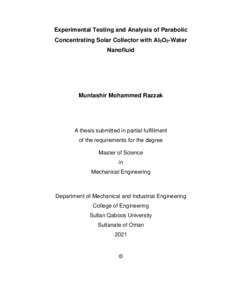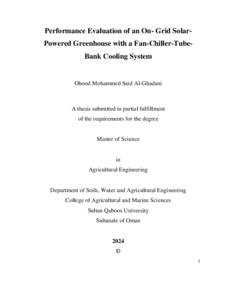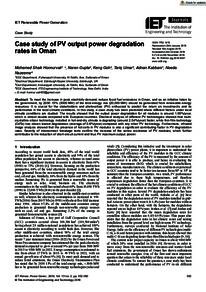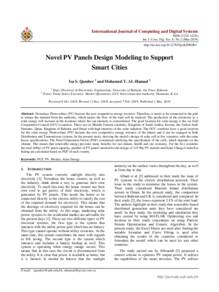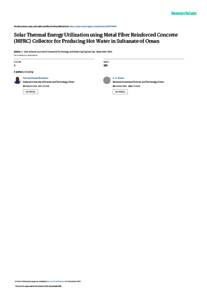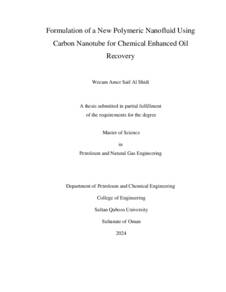Document
Experimental testing and analysis of parabolic concentrating solar collector with Al2O3-water nanofluid.
Other titles
اختبار وتحليل تجريبي لمجمع الطاقة الشمسية المركزة المكافيء باستخدام المائع النانوي Al2O3-Water
Publisher
Sultan Qaboos University.
Gregorian
2021
Language
English
English abstract
Oman is an equatorial country that receives abundant solar energy. Perhaps the
best method of harnessing this high availability of solar energy, both for private
and commercial use, would be to employ solar collectors. These collectors can
be of several types, such as non-concentrating flat plate or concentrating type.
Parabolic trough collectors are concentrating collector's ideal for water heating,
space heating and generation of electricity. It has been observed that nature and
properties of the working fluid in the solar collectors and the type of receiver tube
in concentrating type collectors can greatly affect its performance.
In this project, a concentrating parabolic trough solar collector was constructed,
and experiments were carried out to measure its performance. 2 types of receiver
tube were utilized and compared – a bare stainless-steel receiver tube and an
evacuated receiver tube. The Heat Transfer Fluid (HTF) used was water and
Aluminum Oxide (Al2O3) Nanofluid of 30 nm diameter nanoparticle size, and the
thermal performance of the nanofluids over the water as working fluid is
contrasted. Nanofluids are fluids which contain immersed nanoparticles within the
base fluid. The advantage that they possess over conventional heat transfer
fluids, is their better thermal conductivity and convective heat transfer coefficients.
The Al2O3 nanofluids were tested at 0.1%, 0.2%, 0.3% and 0.4% mass
concentrations. Five different flow rates were used, ranging from 46 l/h to 138 l/h.
Tests with the stainless-steel tube with water as the heat transfer fluid produced
efficiency of 27% at a flow rate of 138 l/h. For tests with the evacuated receiver
tube, the peak efficiency was 30.1% at the same flow rate, similar heat flux and
operating conditions. Using evacuated receiver tube compared to the bare
stainless-steel tube always produced thermal efficiency of approximately 3%
higher. With regards to the variation of efficiency with the solar flux and time, it
was determined that the highest efficiency is usually obtained at 12:30 PM in the
afternoon, when the flux is highest.
Subsequently experiments are repeated with Aluminum Oxide nanofluids of the 4
mass concentrations. Al2O3 of 0.4% mass concentrations produced better thermal
efficiency results than lower mass concentrations. All the mass concentrations
produced better efficiency than water. The peak thermal efficiency of 39.1% was
obtained using the evacuated receiver tube and 0.4% mass fraction of nanofluids,
flowing at 138 l/h. Under the same conditions for water as the HTF, the peak
efficiency was 30.1%. Nanofluids also consistently gave better temperature
difference compared to water when testing conditions were similar. On average
the use of nanofluids over water provided an efficiency improvement of up to 9%.
Therefore, from the results it can be concluded that the performance of the
concentrating parabolic trough solar collector is enhanced by the usage of an
evacuated receiver tube and aluminum oxide nanofluids as working fluids.
Member of
Resource URL
Arabic abstract
عمان بلد استوائي يتعرض لطاقة شمسية وفيرة. ربما تكون أفضل طريقة لتسخير هذا التوفر العالي للطاقة الشمسية، لللاستخدام الخاص والتجاري على حد سواء، هي استخدام مجمعات الطاقة الشمسية. يمكن أن تكون هذه المجمعات عدة أنواع، مثل اللوح المسطح غير المركز أو النوع المرّكز. مجمعات األحواض المكافئة هي مجمعات مركزة مثالية لتسخين المياه وتدفئة األماكن وتوليد الكهرباء. لقد لوحظ أن طبيعة وخصائص سائل العمل في مجمعات الطاقة الشمسية ونوع أنبوب المستقبل في المجمعات من النوع المر ّكز يمكن أن تؤثر بشكل كبير على أدائها. في هذا المشروع تم بناء مج ّمع شمسي مر ّكز ذو حوض مكافئ، وأجريت تجارب لقياس أدائه. تم استخدام ومقارنة نوعين من أنابيب الاستقبال - أنبوب استقبال مكشوف من الفوالذ المقاوم للصدأ وأنبوب استقبال مفرغ. كان سائل نقل الحرارة ) HTF )المستخدم عبارة عن الماء وأكسيد الألمنيوم )3O2Al )نانوي، بحجم جزيئات متناهية الصغر بقطر 30 نانومتر، وتم مقارنة األداء الحراري للسوائل النانوية مع الماء كسائل عمل. الموائع النانو ية عبارة عن سوائل تحتوي على جزيئات نانوية مغمورة داخل السائل األساسي. الميزة التي تمتلكها على سوائل نقل الحرارة التقليدية، هي التوصيل الحراري األفضل ومعامالت نقل الحرارة بالحمل الحراري. تم اختبار السوائل النانوية 3O2Al بتركيزات كتلة ،٪0.1 ،٪0.2 ٪0.3 و.٪0.4 تم استخدام خمسة معدالت تدفق مختلفة تتراوح من 46 لتر / ساعة إلى 138 لتر / ساعة. تم إجراء االختبارات باستخدام أنبوب فوالذي مقاوم للصدأ مع الماء كمائع لنقل الحرارة حيث أنتج كفاءة بنسبة ٪27 بمعدل تدفق 138 لت ًرا / ساعة. بالنسبة لالختبارات باستخدام أنبوب المستقبل المفرغ، كانت ذروة الكفاءة ٪30.1 بنفس معدل التدفق وتدفق الحرارة وظروف التشغيل المماثلة. أدى استخدام أنبوب باألنبوب الفوالذي المقاوم للصدأ إلى إنتاج كفاءة حرارية أعلى بنسبة المستقبل المفرغ مقارنة ٪3 تقريبًا. ً فيما يتعلق باختالف الكفاءة مع التدفق الشمسي والوقت، فقد وجد أن أعلى كفاءة يتم الحصول عليها عادةً في الساعة 12:30 مسا ًء في فترة ما بعد الظهر، عندما يكون التدفق في أعلى مستوى. تكررت التجارب الالحقة باستخدام موائع أكسيد الألمنيوم النانوية بالتركيزات الأربعة. أنتج 3O2Al بتركيزات كتلة ٪0.4 نتائج كفاءة حرارية أفضل من تركيزات الكتلة المنخفضة. أنتجت جميع التراكيز كفاءة أفضل من الماء. تم الحصول على أعلى كفاءة حرارية بنسبة ٪39.1 باستخدام أنبوب المستقبل المفرغ وبتركيز ٪0.4 من السوائل النانوية، مع تدفق بمعدل 138 لتر / ساعة. في ظل نفس ظروف الماء viii ا أفضل في درجة كسائل نقل حراري HTF، كانت ذروة الكفاءة .٪30.1 أعطت الموائع النانوية أي ًضا فرقً بالماء عندما كانت ظروف االختبار متشابهة. في المتوسط، أدى استخدام الحرارة بشكل ثابت مقارنةً السوائل النانوية فوق الماء إلى تحسين الكفاءة بنسبة تصل إلى .٪9 لذلك، من النتائج المحصلة في هذا المشروع يمكن استنتاج أن أداء المجمع الشمسي ذو القطع المكافئ المر ّكز يتم تحسينه عن طريق استخدام أنبوب المستقبل المفرغ وسوائل أكسيد الألمنيوم النانوية كسوائل عمل.
Category
Theses and Dissertations

